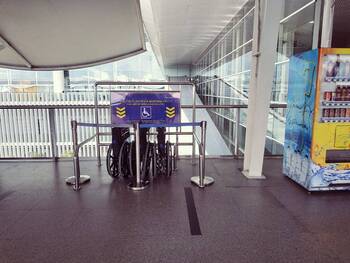Navigating airports can be a daunting task, even for the most seasoned traveler. For those requiring mobility assistance, the process can be particularly challenging. Airport wheelchair assistance services are designed to ease the journey for passengers with reduced mobility, ensuring a smooth and stress-free experience from check-in to boarding. This comprehensive guide explores everything you need to know about airport wheelchair assistance, including how to arrange it, what to expect, and tips for making the most of these services.
Understanding Airport Wheelchair Assistance
Airport wheelchair assistance is a service provided by airlines and airports to help passengers with reduced mobility move through the airport. This service is essential for those who find walking long distances difficult or impossible due to physical limitations, temporary injuries, or medical conditions. The primary goal is to ensure these passengers can navigate the airport safely and comfortably, without undue stress or delay.
How to Arrange Wheelchair Assistance
 1. Booking Your Flight
1. Booking Your Flight
When booking your flight, it’s crucial to indicate your need for wheelchair assistance. Most airlines allow you to request assistance during the booking process, either online or through their customer service. If booking online, look for a section where you can specify special needs or assistance requests. If you miss this step, contact the airline directly as soon as possible to ensure your needs are noted.
2. Pre-Flight Confirmation
A few days before your flight, call the airline to confirm your wheelchair assistance request. This reconfirmation helps prevent any last-minute issues and ensures that the assistance will be ready for you when you arrive at the airport.
3. Arrival at the Airport
Upon arriving at the airport, locate the designated assistance desk or speak with an airline representative at the check-in counter. Inform them that you have requested wheelchair assistance. They will arrange for a wheelchair and an attendant to assist you through the various airport procedures.
What to Expect from Airport Wheelchair Assistance
1. Check-In
The attendant will help you with the check-in process, ensuring that your baggage is checked and that you receive your boarding pass. They will also assist with any special requests, such as seating preferences or additional services you might need on the flight.
2. Security Screening
Navigating airport security can be stressful, but with wheelchair assistance, the process is significantly smoother. The attendant will guide you through security, ensuring you receive any necessary accommodations, such as bypassing long lines or undergoing alternative screening procedures if you are unable to stand or walk through the standard screening devices.
3. Moving Through the Airport
Airports are vast, and getting from check-in to your gate can involve long walks and multiple elevators or escalators. Your attendant will navigate these routes for you, ensuring you reach your gate comfortably and on time. They will also assist with any necessary stops along the way, such as restroom visits or food and beverage purchases.
4. Boarding the Aircraft
When it’s time to board, your attendant will take you directly to the boarding gate. Airlines typically offer pre-boarding for passengers requiring assistance, allowing you to board the plane before general boarding begins. This ensures you have ample time to get settled without feeling rushed.
5. Arrival at Your Destination
Upon landing, wheelchair assistance will be available to help you disembark the plane and navigate the arrival airport. The attendant will guide you through customs and immigration (if applicable), baggage claim, and to your onward transportation, whether it’s a taxi, shuttle, or a friend picking you up.
Tips for a Smooth Experience
1. Plan Ahead
Request wheelchair assistance as early as possible, ideally when booking your flight. Airlines have limited resources, and early requests help ensure that your needs will be met.
2. Reconfirm Before Travel
Always reconfirm your request for assistance a few days before your flight. This additional step can prevent any misunderstandings or lapses in communication.
3. Arrive Early
Give yourself plenty of time at the airport. Arriving early reduces stress and allows for any unexpected delays in the assistance process.
 4. Carry Necessary Documentation
4. Carry Necessary Documentation
Have your travel documents, identification, and any medical documentation easily accessible. This can expedite the check-in and security screening processes.
5. Communicate Clearly
Clearly communicate your needs to the airline staff and the assistance attendant. If you require specific accommodations or have any concerns, don’t hesitate to speak up.
6. Bring Comfort Items
Traveling can be tiring, so bring items that can make your journey more comfortable, such as a cushion, blanket, or snacks. If you take medication, ensure it’s easily accessible during the flight.
The Importance of Airport Wheelchair Assistance
Airport wheelchair assistance is more than just a convenience; it’s a vital service that ensures accessibility and equality for all travelers. By providing support to those who need it, airports and airlines uphold the principles of inclusivity and customer care. This service not only benefits passengers with permanent disabilities but also those with temporary conditions or injuries, elderly travelers, and others who find navigating airports challenging.
Conclusion
Airport wheelchair assistance is an invaluable resource for passengers with reduced mobility, offering them a seamless and stress-free travel experience. By understanding how to arrange this service, what to expect, and how to prepare, travelers can ensure they receive the support they need from check-in to their final destination. Whether you’re a frequent flyer or an occasional traveler, knowing how to utilize airport wheelchair assistance can make all the difference in your journey, allowing you to travel with confidence and ease.
In the end, the goal of airport wheelchair assistance is to provide a travel experience that is as smooth and enjoyable as possible, ensuring that every passenger, regardless of their mobility, can reach their destination comfortably and with dignity.

